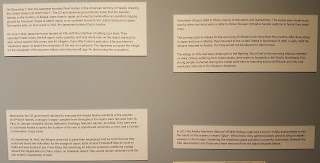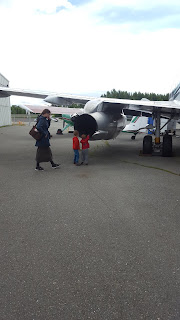Port Hood, the aviation museum and learning about the Japanese invasion of Alaska in Anchorage
Thursday morning we didn't get out of bed until 9 but we were both still exhausted. The first thing I did was pump a whole bunch of grease in the 2 air cylinders I had previously drilled holes in and worked it around until they were working better. However while this fixed one problem it created another. It used to be the cylinders would leak on their way up but seal when fully extended because the pistons would seal against the top cap but now I had drilled holes in the top caps to get grease in and the one leaks very badly when fully extended. I threaded some wood screws into the holes which slowed it down but now once the cylinders are fully extended we can only put 2 solid posts in, then we have to pump some more air in before doing the second 2.
We didn't finish breakfast until after noon and left the campsite around 1 pm for the aviation museum in anchorage. The museum is in the largest seaplane base in the world- Port Hood. According to Wikipedia they see around 190 flights a day and 781 aircraft live at the port. That itself was pretty incredible to drive through, you just keep driving past rows and rows of small single engine planes.
I am including a lot of photos about the Japanese invasion of Alaska in WW 2 because I don't think it is very well known and the battle was very poorly done by the Allies. The Japanese holding American soil for nearly a year is also what led to a lot of the development in Alaska. Most of the info is in the photos but I missed taking photos of some signs and we learned a lot from a half hour or so video they had. The parts I missed in these photos were that the Americans knew the Japanese were coming but couldn't find them. The Japanese attacked the American base before occupying 2 islands. It was 8 months before the Americans managed to stop the Japanese supply convoys to the Japanese soldiers on the islands when an American blockade met a Japanese convoy and although the American ships were outnumbered, badly damaged, and going to loose that battle the Japanese convoy suddenly left and didn't return. The Japanese only got supplies from submarines after that battle. It was over 11 months before the Americans attempted a land invasion with troops that were trained for and dressed for battle in Africa. Wikipedia states 1,200 men received severe injuries from the cold weather and 614 Americans died from disease during the land invasion. The Japanese had trenched themselves in just above the fog line in the mountains so that the Americans couldn't see them which drug the war out and even near the end on the first island the Japanese carried out one of the largest banzai charges of the Pacific campaign which penetrated so deep into US lines that Japanese soldiers were fighting in hand to hand combat with the rear-echelon units of the Americans-that's the units in charge of administrative and supply duties located a considerable distance from the front lines. It took 3 weeks to capture that island- the Japanese held it a week short of a year.
The worst part was the second island which they waited for 2.5 months after capturing the first island to attack. The Allies expected more Japanese to be here and had spent the previous 14 months dropping 7 million pounds of bombs on it. They went to attack it with a much better prepared army 3 times the size they attacked the first island with but a Japanese convoy had gotten past the american ships and evacuated the 5000 Japanese soldiers 2 weeks earlier. When the allies landed they were unopposed just like on the first island and they thought it was a battle ploy of the Japanese. Allied casualties on Kiska island numbered 313 with 103 of those being deaths. They were the result of friendly fire, booby traps, disease or frostbite- all to find out the island was deserted.
There was a lot to see at the museum, there was the 737 that transported caribou,
A fighter plane
pratt and whitneys first engine
shawn standing beside an 18 cylinder 2200hp radial engine
strange planes:
In 1924 the US army decided they wanted to do the first round-the-world flight. They had 4 airplanes built in the hopes that one would make it and 2 of them finished in just under 6 months. The one plane crashed in Alaska and this is the wreckage, the other crashed in the North Atlantic
A guy failed in trying to fly the first airplane over the north pole so the first flight over the north pole was in an airship that left from Rome.
Then we watches the seaplanes take off and land from the tower
We spent until 5pm there and then wanted to go to the info center but it was all paid parking so we just went back to the campsite since we thought having to pay for parking at a visitor info center was a little silly.
















































Comments
Post a Comment